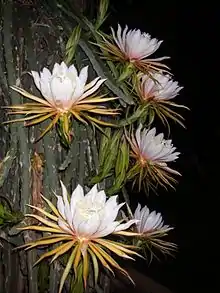Hylocereus
Hylocereus is a former genus of epiphytic cacti, often referred to as night-blooming cactus (though the term is also used for many other cacti). Several species previously placed in the genus have large edible fruits, which are known as pitayas, pitahayas or dragonfruits. In 2017, a molecular phylogenetic study confirmed an earlier finding that the genus Hylocereus was nested within Selenicereus, so all the species of Hylocereus were transferred to Selenicereus.

Description
The species previously placed in the genus Hylocereus grow hanging, climbing or epiphytic. They are freely branched, shrubby plants that form aerial roots and become very large with a height of 10 m or more. The green, often glaucous shoots are usually terete or triangular.[1]
Taxonomy
In the 1994 classification of the International Cactaceae Systematics Group of the International Organization for Succulent Plant Study, the genus Hylocereus was one of the six genera of the tribe Hylocereeae.[2] A 2011 study of the molecular phylogeny of the Cactaceae concluded that neither the tribe nor the genus was monophyletic (i.e. neither comprised all the descendants of a common ancestor). Two species of Hylocereus formed a clade with two species of Selenicereus, suggesting that the genera were not distinct.[3] This result was confirmed in a larger study in 2017, and all the species of Hylocereus were transferred to Selenicereus.[4]
Species
Species that were placed in the genus in 2012 that are now placed in Selenicereus include the following.[5][4]
- Hylocereus calcaratus (F.A.C. Weber) Britton & Rose → Selenicereus calcaratus
- Hylocereus costaricensis (F.A.C. Weber) Britton & Rose → Selenicereus costaricensis
- Hylocereus escuintlensis Kimnach → Selenicereus escuintlensis
- Hylocereus megalanthus (K. Schum. ex Vaupel) Ralf Bauer → Selenicereus megalanthus
- Hylocereus monacanthus (Lem.) Britton & Rose → Selenicereus monacanthus
- Hylocereus minutiflorus Britton & Rose → Selenicereus minutiflorus
- Hylocereus ocamponis (Salm-Dyck) Britton & Rose → Selenicereus ocamponis
- Hylocereus setaceus (Salm-Dyck ex DC.) Ralf Bauer → Selenicereus setaceus
- Hylocereus stenopterus (F.A.C. Weber) Britton & Rose → Selenicereus stenopterus
- Hylocereus triangularis (L.) Britton & Rose → Selenicereus triangularis
- Hylocereus trigonus (Haw.) Saff. → Selenicereus trigonus
- Hylocereus undatus (Haw.) Britton & Rose → Selenicereus undatus
See also
- Epiphyllum – another cactus genus yielding edible fruits
References
- "On-line Guide to the positive identification of Members of the Cactus Family". On-line Guide to the positive identification of Members of the Cactus Family. Retrieved 2019-07-25.
- Anderson, Edward F. (2001), The Cactus Family, Pentland, Oregon: Timber Press, ISBN 978-0-88192-498-5, p. 101
- Bárcenas, Rolando T.; Yesson, Chris & Hawkins, Julie A. (2011), "Molecular systematics of the Cactaceae", Cladistics, 27 (5): 470–489, doi:10.1111/j.1096-0031.2011.00350.x, PMID 34875796, S2CID 83525136
- Korotkova, Nadja; Borsch, Thomas & Arias, Salvador (2017). "A phylogenetic framework for the Hylocereeae (Cactaceae) and implications for the circumscription of the genera". Phytotaxa. 327 (1): 1–46. doi:10.11646/phytotaxa.327.1.1.
- "Search results". The Plant List. 2012-03-23. Retrieved 2019-07-24.